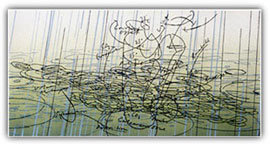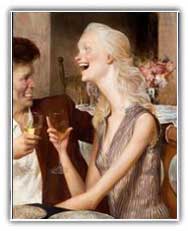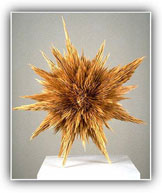The Visual Arts: Blurring the Boundaries
By Eleanor Heartney

|
Once it was possible to sum up current trends in American art with a few deftly put phrases -- "abstract, gestural painting" could have served at one point, or "return to figuration" at another. Today it is much more difficult to pinpoint the dominant approach with anywhere near this kind of precision. In part, this is because art has changed, in part because the world has changed. Nevertheless, I believe that there are sets of tendencies that art today is following. These are often best understood by looking at individual artists who exemplify them, and thinking about how these artists are stretching our understanding and definitions of art.
But before we can do that, it might be helpful to look more closely at the idea of "American art." This apparently simple category is actually much more complex than it appears. The conviction that there is such a thing as "American style" painting or sculpture that partakes of some quintessentially "American" quality was once an immutable tenet of modernist art criticism. Today, however, "American art" is no longer a simple matter of geography, national origin, or point of view. Instead, the globalization of markets, the ease of international communication, and the nomadic movement of artists from one country to another have all contributed to an art world without firm concepts of national identity. It is common for artists to list multiple countries as their home and to refer to themselves in hyphenated ways. I recently attended an exhibition comprising artists from all over the world. I kept meeting interesting international artists -- this one hailed from Cuba, this one from Nigeria, that one from China -- only to discover that they now live within a few miles of me in New York City.
This fluidity is an important element in any discussion of American art today. The evaporation of the borders between nations, at least in the field of art, mirrors the disappearance of all kinds of other boundaries as well. Hardly anyone worries about the unique characteristics of painting and sculpture any more. Just as artists hopscotch around the globe, they vault effortlessly across media, producing work that simultaneously incorporates not only traditional materials but also digital technology, theatrical installation, photography, performance, music, film, and video.
Similarly, "public art" once meant a massive sculpture set on a public plaza. Now public art is just as likely to appear on the Internet or to involve small groups of community members working together on a project of local interest. Equally changed is the old idea that art should confine itself to its own sphere. Artists today incorporate science, politics, religion, architecture, and ecology into their work and hope to have impact that stretches far beyond the gallery walls.
The Expanding Definition of Art
Navigating this brave new world of art takes an agile mind and a willingness to put aside preconceived ideas. This becomes clear from any survey of some of the artists provoking discussion today.
One of the most celebrated artists of the moment is Matthew Barney, an artist/filmmaker who has been the subject of a major retrospective exhibition at the Guggenheim Museum in New York. Barney is both a filmmaker and an installation artist -- although his installations largely consist of props from the sets of his films. His magnum opus is a seven-hour-long, five-section film entitled Cremaster. Although each segment resembles a feature film both in length and visual polish, there are some significant differences between what you see at the local cinema and the films Barney offers for view. His whole opus contains only 12 lines of dialogue, and it is filled with outlandish characters and creatures that cross both gender and species lines. There is a cheetah woman, a tap dancing satyr, a bagpipe-playing Scot, a re-imagined Harry Houdini played by writer Norman Mailer, and a tragic queen played by actress Ursula Andress. The five sections make reference to everything from the 1930s Hollywood dance sequences of Busby Berkeley to murderer Gary Gilmore to Masonic ritual. The narrative is highly ambiguous, and critics are divided over its meaning.
|
What makes Barney one of the most hotly debated artists today is the way he blends popular culture, private fantasy, references to high art and architecture, and striking imagery into a complex and demanding cinematic world that is as convincing on its own terms as it is difficult to fathom. Barney's works bear and even demand repeat viewings during which his carefully crafted set of private symbols weave together in increasingly coherent ways.
Barney's Cremaster series suggests how art can merge with film to create something that is quite far from our conventional expectations of either. Something similar goes on in the marriage of art and architecture that takes place in the work of Elizabeth Diller and Ricardo Scofidio.
Trained architects who are equally at home in the world of art, Diller and Scofidio create work that questions what architecture is and how it functions in the world. Their most famous work is a beach house, commissioned but never built, whose raison d'etre is the view from a single window. The model of the otherwise windowless house curves in such a way that this view is inaccessible until one has passed through its interior, which, almost incidentally, contains all the features -- kitchen, living room, bedroom -- of a normal house. But the real point of the structure is the large glass window at the farthest end that, paradoxically, turns out to be a kind of holy grail, never to be actually possessed. For once visitors have passed through the house to reach the much-anticipated view, they discover it is largely obscured by a video that presents a recorded version of the actual view just beyond it. Thus, the house operates both as a functioning building and a work of conceptual art that asks us to question how we perceive reality.
Diller and Scofidio have also explored the way that our experience of space is altered by surveillance. This is an outgrowth of their early interest in how windows have created a new sense of transparency in modernist architecture. One such project involves a design for a restaurant interior in which surveillance cameras are aimed at people in the bar. Their images are then played on monitors visible to passers-by on the street outside. Hence this work reverses the usual relationship of watchers and watched, again changing our perceptions of our relation to the world.
Art As Life
Such works expand the definition of art by aligning it with architecture. In a similar way, other artists graft their art activity onto corporate models of organization. This is the strategy chosen by Julia Scher, who is a bonded security professional with her own company called Security by Julia. Creating works in galleries and other institutions, she borrows the paraphernalia of security companies -- surveillance cameras, monitors, soothing recorded voices, and office desks manned by people wearing her signature pink security uniforms. For the opening of a show at Andrea Rosen Gallery in New York, Scher hired surveillance helicopters to film visitors entering and leaving the gallery and played their images on monitors inside. Such installations both parody and undermine contemporary reliance on technology to ensure our sense of personal and public safety. Because they touch on the emergence of an industry that is becoming an increasingly intrusive feature of modern life, Scher's installations have found wide audiences throughout the United States, Europe, and Asia.
Such artists offer a new twist on the old avant-garde dream of erasing the boundary between art and life. In a sense, in their work, art becomes life. This impulse also underlies some of the most innovative approaches to contemporary public art. Moving far beyond the notion of "plop art," in which a piece of welded steel is dropped in the middle of a public square, many artists who work in the public realm today work to actively engage members of the community in which their art work will appear. Once again, this can lead to art projects that bear very little resemblance to conventional works of art.
The artist J. Morgan Puett created a particularly engaging example of this approach for the Spoleto Festival in Charleston, South Carolina, in 2002. Her work was titled Cottage Industry, and on one level that is exactly what it was. Puett took over an abandoned clapboard house in a formerly African-American neighborhood that has been emptied of residents pending urban renewal. She turned this weathered structure into a small clothing factory. Working with local weavers, seamstresses, and dyers, Puett created a line of textiles and garments that mixed references to the clothing worn by both plantation owners and plantation slaves of South Carolina's pre-Civil War past. A single dress might combine corsets of the sort favored by a real-life Scarlett O'Hara with the rough muslin undergarments worn by her maid, thus aesthetically breaking the class barriers that once separated masters and servants.
For the duration of the exhibition, her artisans took over the house, setting up conference rooms, a design studio, a sewing parlor, a weaving area, and a shop where visitors could place orders for garments. From a political perspective, Puett had several points to make. The work served as a reminder of Charleston's difficult history. It also provided a model for the type of small business enterprises that the area's residents might undertake. And it helped get art and non-art people talking about the impact of urban renewal on the city's most vulnerable residents. The "art" part of the project involved both the creation of whimsical costumes and the mobilization of Charleston artisans.
Profile: Artist Tom Friedman
A cereal box. A handful of toothpicks. Soap powder. Sugar cubes. These are among the media that are close to the heart of artist-sculptor Tom Friedman, whose wit and inventiveness have helped redefine contemporary art. Utilizing already-chewed bubble gum, masking tape, colored Styrofoam cups, paper straws, and other commonplace items as his materials, Friedman, 37, has become a popular new talent in the United States and abroad. His creations have their origins in the pop art of the Andy Warhol school and in minimalism, but, invariably, they take their own clever course. "I try to transform these materials into objects for contemplation, to make them self-reflexive, continually coming back to themselves," the artist has said of his work. "By using a process or finding a logic that redefines them, it kind of takes them from the familiar to the unfamiliar." Glue score upon score of toothpicks together in a particular pattern, the artist is saying, and the result -- call it a starburst or a snowflake (Friedman has chosen to label the 1995 piece Untitled) -- can be ethereal. Styrofoam balls, stacked one upon another, resemble one's impression of an alien form. An aspirin tablet can be shaped into a self-portrait cameo. "The materials may be mundane," one observer noted, "but the artistry is exceptional." Friedman, a native of St. Louis, Missouri, studied graphic illustration in college and sculpture during his graduate work. He held his first solo exhibitions in 1991 in Chicago and New York City, and he has been presented in museums in Geneva, London, Stockholm, Rome, Tokyo, and Milan, as well as across the United States. As one critic describes what Friedman has accomplished: "The ordinary morphs into the extraordinary, the literal mutates into the abstract…simplicity belies complexity, and the familiar becomes strange. Best of all, it's accomplished without pretense, with only the mildest degree of assertiveness. It invites; it doesn't demand." |
The Virtual Realm
American art is also colonizing the virtual realm, as artists create works that must be experienced on-line. One of the most ambitious of these is Matthew Ritchie, who has invented a whole cosmology that is presented and somewhat cryptically explained on his Web site. Based on the creation myths of the Western world and employing the sort of interactive technology used in Internet games, Ritchie's project centers around a group of seven damaged celestial agents who represent different parts of the human brain. Thrown from heaven, they fall to earth and shatter into segments across seven continents. These fragmentary creatures combine and recombine, making for an almost infinite set of possible narratives that the Web audience may pursue.
Meanwhile, for those who prefer their art to keep at least one foot in the "real" world, Ritchie also translates his narratives into abstract paintings that wrap across walls, ceilings, and gallery floors. One of these was installed as a permanent mural at the Massachusetts Institute of Technology in Boston. In the end, although the story he tells may not be clear in all its details, it is evident that Ritchie has produced an allegory of creation that celebrates the artist's role as inventor of new worlds.
Artists also meld digital technology with more traditional media. One striking example is Shahzia Sikander, a New York-based, Pakistani-born artist who studied traditional miniature painting. She is best known for her delicate watercolor paintings that blend aspects of Hindu and Islamic images of women in fantastical ways. However, during a residency in Texas, she created a digital "painting" in which fragmentary images, texts, and symbols drawn from Asian and Western art traditions slowly fade in and out of the surface of a small light box. This process allows her to make a graphic image of the kaleidoscopic nature of identity as experienced by emigr?artists in today's globalized art world.
The Conventional…With a Twist
All this exploration of new media is not to suggest that artists have abandoned conventional art media. Another contemporary trend is the reworking of venerable art traditions. Here the boundary that blurs is that which separates past and present. Turning their backs on the evolutionary theory of art history, such artists mine traditions that have long been declared moribund.
For instance, Walton Ford creates nature paintings that capture both the obsessive realism and the elegant compositions of 19th century artist John James Audubon's naturalist illustrations of flora and fauna. However, Ford provides a twist -- introducing humorous details that transform his paintings into satiric allegories of empire. In a set of paintings in a show at Paul Kasmin Gallery in New York, a monkey grasps pages of an explorer's diary while holding a hookah. In another, a giant starling appears poised to swallow a smaller bird.
John Currin performs a similar operation on the hoary genres of the nude and the portrait. His meticulous oil paintings mimic the Northern Renaissance of the 15th and 16th centuries and early well-known traditions -- mannerist traditions -- but again something is not quite right. He introduces distortions of body or facial features, and endows his characters with a vapid stare that seems to have more to do with contemporary fashion models than old master painting. The result is simultaneously old and new, obscuring the distinctions between historical and contemporary consciousness.
Breaking Boundaries
This brief survey should make it clear that contemporary art is given to shape shifting and boundary blasting. If anything unites the very disparate tendencies visible today, it is an unwillingness to be bound by a simple definition of "art." This development marks a sea change from older notions of art, which stressed its separation from life and its tendency to progress and change according to internally dictated rules. Now, change is as much a function of occurrences outside art as within it.
In an era of breaking boundaries, the task of the critic consequently becomes more difficult and more interesting. It is no longer possible to write about contemporary art in the United States as a series of formal developments or as an orderly succession of movements. Instead, art becomes a way of filtering the multifarious and contradictory information that bombards us from every direction. Free to draw from every discipline, every art tradition, and every mode of presentation, contemporary art turns out to be just as complex, provocative, and intellectually demanding as the world that has produced it.
_____Eleanor Heartney is an internationally published art critic, a contributing editor to Art in America, and the author of Critical Condition: American Culture at the Crossroads and Postmodernism.
A Conversation With Kathy Halbreich
Q: During your tenure at the Walker Art Center, what do you see as the most significant development or trend? A: When I became a museum director in 1991, one of the first things I did was to try to find my way and better understand other institutions' missions. While those missions included serious research resulting in the development of original exhibitions and important additions to their permanent collections, very few, if any, mentioned those we are serving. In other words, very few included the word "people" in their mission statements. Over the years, many organizations have become more bifocal. We remain seriously committed to the art, but there has been a shift to the practitioner -- the artist -- and, even more critically, a heightened awareness of the diversity of the audience we serve. So for me, the major development over the last decade has been placing people at the center of our mission. The Walker -- and we're not alone in this -- has opened its thinking and doors to previously underserved audiences, particularly teenagers. This came out of my own sense of the power of art to transform my thinking and to broaden my mind as a young person. When I first saw a canvas by Pollock, it reflected my own internal sense of the chaos and order I was struggling to understand as an adolescent. Having had that experience, I thought -- as a director -- that it was important to make teenagers part of the pleasures and rewards of cultural institutions. Teenagers do precisely what artists do: They rock the boat, they ask questions outside the box, and their needs challenge the status quo. One of the other huge changes in the field is the acknowledgement that no one person or institution owns expertise, that no one can possibly be expert in all the cultures of the world. So museums' commitment to becoming genuinely public or civic institutions has been accompanied by a commitment to broaden our own understanding of our field and our expertise, as well as of the values that shape them. Q: Have you seen creative or artistic influences from overseas expanding over the last 10 years? A: Absolutely. Our mission at the Walker, which is unique, is animated by three adjectives: multidisciplinary, diverse, and global. "Multidisciplinary" means that we shelter not only the visual arts but also the performing arts, film/video and new media. "Diverse," as a concept, is reflected in everything from who serves on the Walker's board of directors and staff to what is shown in the screening room, on the stage, and in the galleries. And "global" acknowledges that not only do we include cultures from around the world, but also that we reflect new ways of thinking about older cultures and their artifacts. A contemporary institution, because it is dealing with living artists, cannot escape the differences of approach from -- as well as those things that connect us with -- Johannesburg and Istanbul and Shanghai. For example, the Walker currently has a year-long educational-artistic program in progress under the theme "How Latitudes Become Forms: Art in a Global Age." This program involves exhibitions, the performing arts, and programs on-line. It is the product of four years of intensive research, travel, and conversation with experts from around the globe. Q: Are there other refinements of thinking among your peers? A: Many of us, for years, didn't really know what to do with "traditional" work. Now there's an understanding that even the most contemporary work is rooted in autobiography, geography, and culture. No longer is there the sense that tradition belongs on one side of the table and contemporary practice on the other. There is an increased alertness to subtlety, complexity, and difference, and an acceptance of this. Q: Do the creative giants of the past still dominate the field, or has a new generation taken hold? A: There will always be creative giants -- which is a blessing. But at the moment, we are realizing that there are more creative giants operating across the globe than we were ever aware of before. It is why, at this particular moment, people are looking beyond their own prescribed borders. Q: What is the greatest challenge you see today? A: Economic instability. It has an enormous impact on our liberty to make choices. I have told my board that whatever choices we make in this economic climate, we must make them with an eye toward preserving freedom -- the freedom to innovate, the freedom to be accessible, and the freedom to create new models of understanding. I don't think we can let money be an excuse for not doing these things, even though the lack of money makes the risks we need to take more daunting. Beyond economics, I think one of the greatest challenges for cultural institutions is to become more sensitive civic partners in the lives of all their constituencies. Q: How do you think the field of art will change over the next 10 years, creatively speaking? A: Ten years from now, I believe there will be new art forms for which we don't yet have names. They will bring together moving pictures, moving performers, and the digital universe. Institutions, out of a sense of tradition and maybe even convenience, tend to break the disciplines into departments. You have a photography department, a painting and sculpture department, a drawing department, and maybe a film department. Today, artists are erasing those boundaries. _____The interview with Kathy Halbreich was conducted by Michael J. Bandler. |
To see our Photo Gallery on VISUAL ARTS go to
http://usinfo.state.gov/journals/itsv/0403/ijse/gallery.htm

Back to top | Contents, U.S. Society & Values, April 2003



